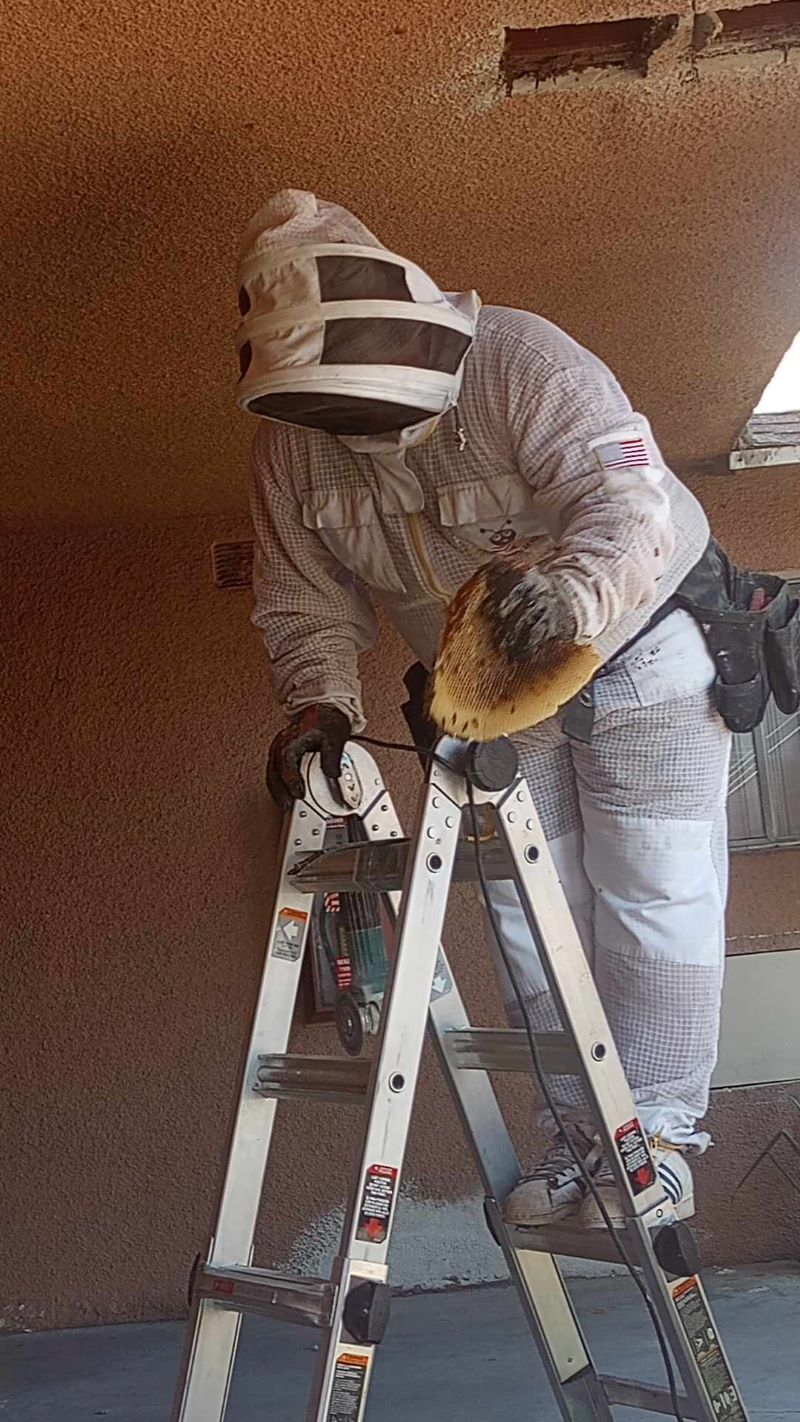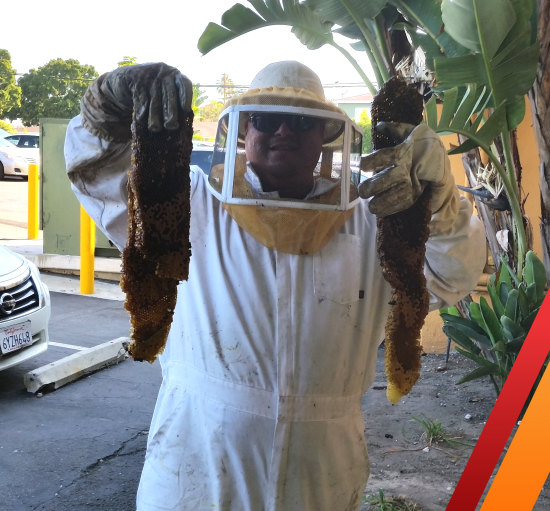Cost Of Bee Removal
The cost of bee removal doesn’t have to sting when it comes to your wallet. The cost of bee removal will differ depending on the type of bees and location. Cost of bee removal will differ depending on the type of bees and location of the bees. The average cost of removing a bee colony could include fees of $150 to $500, though this cost will vary depending on the type of hive. A displaced swarm (a colony without a hive) will cost up to $250 to capture and relocate. Ease of access also plays a factor, as a local professional beekeeper or exterminator may need to get into your walls or ceilings to find a hive. So count on carpentry costs of up to $2,000 after the removal has been completed. Before deciding it’s important to identify the type of beehives on your property as each requires special considerations. Here’s a further breakdown of each species of bee and the cost variations you can expect.
Honey Bee Removal
Removing honey bees costs around $550, or between $100 and $1,000. The broad cost range is because where they nest dictates how difficult they are to remove and how much you’ll pay. Additionally, honey bee nests can hold up to 50,000 bees and cover a huge area.
Africanized Honey Bee Removal
Killer bees are really called Africanized honeybees, but they got their aggressive moniker because they are known to chase humans or animals if they think their territory is being threatened. Even if you fancy yourself a budding beekeeper, this is likely not the time to test out your skills. You can hire a pro for $100 to $1,000 to do it safely for you.he typical price of bumble bee removal is $140, with a range of just $80 to $200. The cost of removing bumble bees is comparatively low because they don’t damage property, their nests are small, and they’re calm and non-aggressive unless threatened.
Carpenter Bee Removal
Carpenter bee removal costs between $100 and $2,500, with most people paying around $1,300. The higher end of the budget is for instances where carpentry repairs are required. Carpenter bees aren’t particularly aggressive, and only the females sting. However, they can cause extensive damage to wood.
Blumble Bee Removal
The typical price of bumble bee removal is $140, with a range of just $80 to $200. The cost of removing bumble bees is comparatively low because they don’t damage property, their nests are small, and they’re calm and non-aggressive unless threatened.

Bee Removal Cost Breakdown
How many bees are in the hive determines how much you’ll pay because the larger the hive, the more time-consuming and difficult the removal is. Smaller infestations can cost as little as $80, while a severe one can cost up to $2,500. Though removing the hive itself can be a relatively quick and painless process, there are a number of other factors to consider when sourcing a pro to identify, relocate, or exterminate an active bee colony. Here’s a breakdown of how you can expect to spend your money.
Bees live in colonies that can range from 20,000 to 80,000 critters in one hive. If you have a large hive or multiple hives, this will impact the price as a professional bee removal expert will have more work to do to get rid of them. Expect to pay around $1,000 to $1,500 for a large nest removal—more if there are multiple, though each won’t cost this much because the initial price likely includes labor, such as cutting into a wall, to gain access. A small, singular hive might only cost $500 or less depending on location.
Location
Bees nesting in your yard cost less to remove than those that nest close to or in your home. Where bees are located in your home can drive up the price you pay for removal. Additionally, when nests are behind walls, which is common with honeybees, the nests can be large and particularly difficult to get rid of. Carpenter bees, too, can be costly to remove, as they nest deep in wood, like your deck or your attic, and the damage they do can be expensive to repair. For example, bees that have festered in a structural wall of your home will likely cost more to remove than a hive attached to a gutter outside. At that point, you also have to figure in repair costs, such as installing new drywall, repairing a deck, or fixing parts of your roof that must be removed to gain access to the bees. There are no hard and fast rules, but here are some cost guidelines based on location
Repairs
Because some bees cause damage to your property with their nest locations, you’ll need to budget for the cost of repairs. If the bee colony has made its home behind a wall or in your ceiling, roof, ext. a beekeeper will have to perform some demolition before removal. After the bees are gone, you may have to pay extra to rebuild the damage. Here are some of the rebuilding costs you may encounter:
Beehive Extermination Considerations
Not all hives are savable. Safety issues due to the Africanized Honey Bee have resulted in states regulating extermination and relocation. Pesticides sprayed by untrained homeowners result in an unhealthy and unusable colony. Always consult a professional pest removal specialist or beekeeper for nest relocation or extermination. Never attempt removal yourself without at least first identifying the type.
Tip: Ask your specialist if removal of the honey and honeycombs is part of the fee. If left behind, it can rot and attract other insects, pests, and other swarms looking for a home.

FAQ
Most frequent questions and answers
1. The bees are not aggressive and in swarm or early hive formation.
2. The bees are easily accessible and are clustered out in the open and not inside a structure.
3. We are able to place them with a beekeeper in our Best Bee Network.
The cost of bee removal varies depending upon a number of factors. There are three main factors that can effect the cost of a job.
1. The first is the length of time the problem has been going on. If you have a swarm it is less expensive to resolve than if you have a hive. A swarm is a collection of bees that has just landed and is looking to build a hive. A fully established hive can be built in only a couple weeks, so fixing the problem quickly (before the swarm has built a hive) is much less expensive than if a hive has already been established.
2. The second factor that influences the price of a job is where the bees or hive is located. Is it in a tree at eye level that is easy to get to? Or is it 25 feet up in a palm tree? Does it require a ladder? Is it on a hillside or up a steep slope? Do you need to crawl under a structure to get to it? Do you need a boom lift or heavy equipment to reach it? All of these factors dictate the difficulty and price of the job.
3. The third main factor is what materials and tools will be needed to remove the hive? Is the hive in a 3nd story wood shingle roof or a single story Spanish tile roof? Are the bees inside an irrigation box in the ground where the lid can be lifted easily? Or are they inside a concrete wall that needs to be demolished in order to get to the hive? Are the bees in a stucco wall, a wood wall, or a type of wall that has special masonry? All of these examples can effect the cost of the hive removal.
We do not recommend you try to deal with this yourself. Handling bees can be tricky. In addition to he proper suits and equipment, knowledge and expertise are required in order to ensure the safety of people and animals in surrounding areas.
